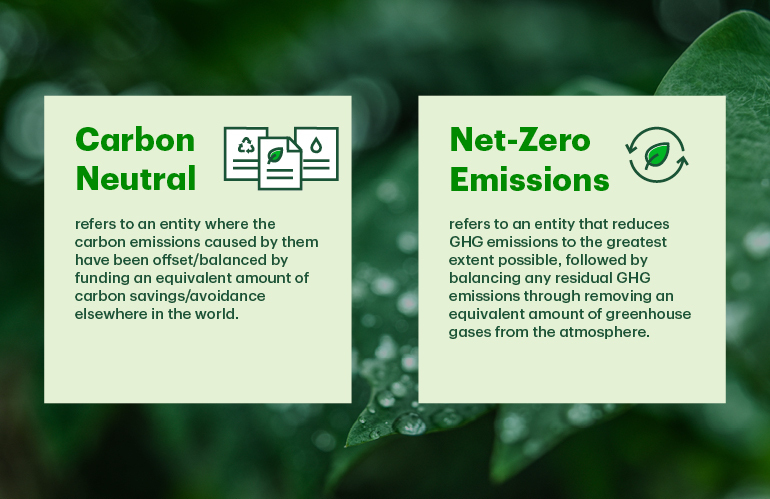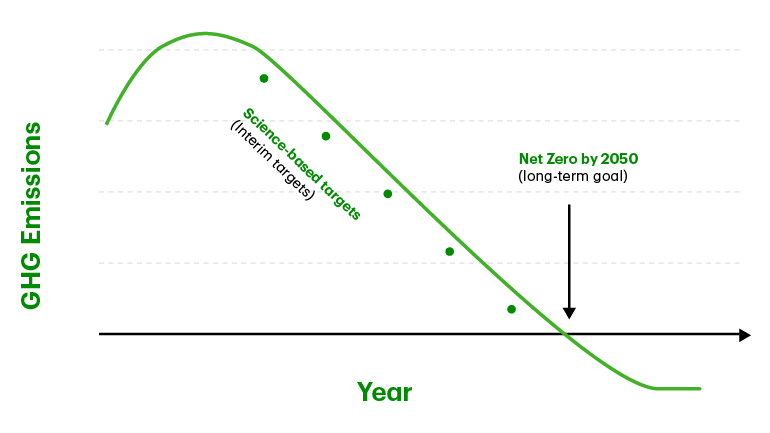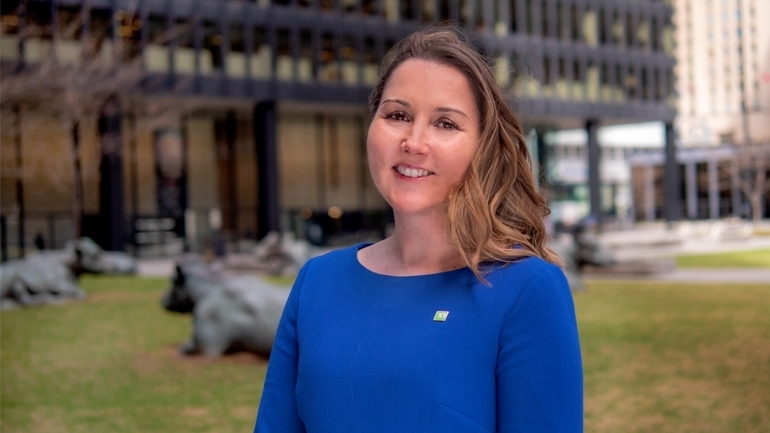Climate change is one of the greatest challenges facing our collective future. Transitioning successfully to a low-carbon future will require significant effort and collaboration across sectors over the long term.
As a global financial institution, we know we have an important role to play in supporting the transition to a low-carbon economy. To help address these challenges, in 2020 TD announced an ambitious Climate Action Plan, building on our long history of environmental progress.
At TD, we are focused on a path to net-zero greenhouse gas (GHG) emissions by 2050 as part of our Climate Action Plan, but what does that mean?
To learn more about it, and how the Bank’s targets to reduce GHG emissions play a critical role in our Climate Action Plan, we spoke to Nicole Vadori, Head of Environment, TD Bank Group.
Let's start off with some context for readers. What exactly is "net zero"?
In short, net zero is at the heart of our climate goals at TD. When companies talk about "net-zero emissions," what they mean is that their business either emits no GHGs or the company offsets its emissions by removing the equivalent amount of GHGs from the air through, for example, funding carbon removals by direct air capture technologies or large-scale forestation projects.
According to the United Nations' Intergovernmental Panel on Climate Change, global net human-caused emissions of carbon dioxide (the most predominant GHG) emissions need to fall by about 45% from 2010 levels by 2030, and reach "net zero" by mid-century (2050), to give the world a good chance of limiting warming to 1.5 degrees Celsius and avoiding the worst impacts of climate change. Under the 2015 Paris Agreement, nearly 200 countries said they would act to curb the rise in global average temperatures.
What do we mean when we talk about the "path to net zero," and how does that compare to "carbon neutral"?
When an organization talks about achieving "net-zero emissions," it is referring to reducing GHG emissions to the greatest extent possible, followed by balancing any residual GHG emissions through removing an equivalent amount of GHGs from the atmosphere, so that the net amount of emissions is essentially zero.
On the other hand, carbon neutrality is achieved when carbon emissions caused by an organization have been balanced by funding the prevention or avoidance of carbon emissions elsewhere in the world.

As we evolve our climate leadership from carbon neutrality to net zero, the scope of our targets expands to include emissions associated with our financing activities ("financed emissions"). Financed emissions are our clients’ emissions apportioned by TD's financing to that client, and they are by far the most significant part of TD's GHG footprint. Planning for net-zero financed emissions is the most challenging part of TD's Climate Action Plan.
TD will remain carbon neutral, as it has since 2010, while we work towards a target of net-zero emissions by 2050. Evolving TD's commitment to net-zero emissions requires the reduction of emissions and the removal of carbon from the atmosphere equivalent to the amount of carbon emitted. As part of the plan, we need to set various targets to measure our progress and ensure we reach our objectives.
What are the different types of targets? And what does "financed emissions targets" mean?
There are indeed different types of targets. Setting financed emissions targets is a key step forward in the Bank’s net-zero journey because they relate to emissions from sources that the Bank does not own or control. In comparison to Scope 1 or Scope 2 emissions, they represent the greatest share of our GHG footprint. Here is the difference:
- Scope 1 emissions are all direct emissions under an organization’s control or from their activities, such as fleet vehicles or onsite space heating.
- Scope 2 emissions are indirect emissions from electricity purchased and used by an organization.
- Scope 3 emissions are all other indirect emissions from an organization’s activities, occurring from sources that they do not own or control, and covering emissions associated with business travel, procurement, capital goods, financing and investments. Scope 3 financed emissions are the emissions of the clients to whom the Bank provides and facilitates capital.
Last year, we announced our interim target for Scope 1 and 2 emissions using a science-based approach and joined the United Nations-convened Net-Zero Banking Alliance (NZBA) in concert with our Canadian peer financial institutions. An emissions reduction target or methodology is defined as "science-based" if it is developed in line with the scale of reductions required to keep global warming well below 2°C and pursue efforts to limit to 1.5°C from pre-industrial levels.

This year we released our first set of Scope 3 financed emissions targets for the Energy and Power Generation sectors. These sectors were prioritized because they are both significant contributors to global GHG emissions and present significant opportunities to assist other sectors in decarbonizing. An initial focus on greening the energy supply is critical to enabling the decarbonization of the broader economy.
What does the path look like?
To reach net zero by 2050 means we must not only address our operational emissions, but also measure the GHG emissions of our clients, particularly in high-emitting sectors of our financing.
Our 2030 financed emissions targets are our interim goals on the path to net zero by 2050, serving as key guideposts for our organization as we further integrate climate-related risks and considerations into our business.
In setting our interim Scope 3 financed emissions targets, we are embarking on a multi-year journey to align our financing portfolio with our net-zero target. We recognize that measurement methodologies and decarbonization scenarios, as well as data quality, will evolve over time. We have made the determination to move ahead despite these challenges, and not wait for a pre-defined pathway.
We believe that data challenges should not impede or delay our objective of transparently tracking and disclosing our financed emissions. Mindful of these challenges, we will recalibrate our approach as appropriate as data improves and methodologies and pathways evolve.
Why is it important for a bank like TD to do this?
As one of the largest banks in North America, we understand that we can play a critical role in helping to create a more inclusive and sustainable future. This is core to our purpose as an organization. But as we confront the pressing challenges presented by climate change and address long-standing economic and social inequities brought to new light by the pandemic, the importance of this work is amplified. Setting our financed emissions targets represents a significant step forward, turning our commitments into action to support the ambitious goals we have set.
It is a priority for us to work with our clients to help them enable their low-carbon transitions. Many of our clients have developed, and started to implement, their own climate change and GHG emission reduction plans, and we expect many others to do so in the coming years. We are committed to supporting and actively engaging with our clients with our full suite of products and services as they execute their emissions reduction plans and seek out low-carbon opportunities.
We know that we as a business can only thrive when society as a whole thrives. Today, we are setting out another important step in our plan – our targets will provide critical guidance for how the Bank plays a role in a responsible transition to a low-carbon economy in the years ahead.
We do not underestimate the scale of the challenge ahead. Many pieces of the puzzle are still missing. The data is imperfect, methodologies are incomplete. There is no consistent global set of standards for measuring GHG emissions.
But the urgency of the climate crisis means we can no longer wait for a pathway to net zero to be neatly laid out before we act. We may not know every step, but the direction is clear.
